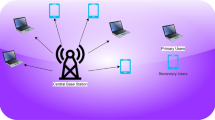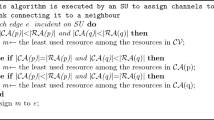Abstract
Cognitive radio networks (CRN) make use of dynamic spectrum access to communicate opportunistically in frequency bands otherwise licensed to incumbent primary users such as TV broadcast. To prevent interference to primary users it is vital for secondary users in CRNs to conduct accurate spectrum sensing, which is especially challenging when the transmission range of primary users is shorter compared to the size of the CRN. This task becomes even more challenging in the presence of malicious secondary users that launch spectrum sensing data falsification (SSDF) attacks by providing false spectrum reports. Existing solutions to detect such malicious behaviors cannot be utilized in scenarios where the transmission range of primary users is limited within a small sub-region of the CRN. In this paper, we present a framework for trustworthy collaboration in spectrum sensing for ad hoc CRNs. This framework incorporates a semi-supervised spatio-spectral anomaly/outlier detection system and a reputation system, both designed to detect byzantine attacks in the form of SSDF from malicious nodes within the CRN. The framework guarantees protection of incumbent primary users’ communication rights while at the same time making optimal use of the spectrum when it is not used by primary users. Simulation carried out under typical network conditions and attack scenarios shows that our proposed framework can achieve spectrum decision accuracy up to 99.3 % and detect malicious nodes up to 98 % of the time.








Similar content being viewed by others
Notes
We use the terms outlier detection and anomaly detection interchangeably.
References
Taher, T. M., Bacchus, R. B., Zdunek, K. J., & Roberson, D. A. (2011). Long-term spectral occupancy findings in Chicago. New Frontiers in Dynamic Spectrum Access Networks (IEEE DySPAN).
FCC’s Overview of LPAD registration procedure. http://www.fcc.gov/help/overview-unlicensed-wireless-microphone-registrations
IEEE STANDARD 802.11af-2013—IEEE standard for information technology—Telecommunications and information exchange between systems—Local and metropolitan area networks—Specific requirements—Part 11: Wireless LAN medium access control (MAC) and physical layer (PHY) specifications amendment 5: Television white spaces (TVWS) Operation.
Chen, R., Park, J., Hou, Y., & Reed, J. (2008). Toward secure distributed spectrum sensing in cognitive radio networks. IEEE Communications Magazine, 46, 50–55.
Wang, W., Li, H., Sun, Y., & Han, Z. (2009). CatchIt: Detect malicious nodes in collaborative spectrum sensing. In IEEE Global Telecommunications Conference, GLOBECOM.
Wang, W., Li, H., Sun, Y., & Han, Z. (2009). Attack-proof collaborative spectrum sensing in cognitive radio networks. In 43rd Annual conference on information sciences and systems, ACISS 2009.
Ling, M. H., Yau, K. A., & Poh, S. (2013). Trust and reputation management in cognitive radio networks: A survey. Wiley Journal of Security & Communication Networks. doi:10.1002/sec.899.
Jana, S., Zeng, K., Cheng, W., & Mohapatra, P. (2012). Trusted collaborative spectrum sensing for mobile cognitive radio networks. In 32nd IEEE international conference on computer communications, INFOCOM 2012.
Kim, M., Chung, M. Y., & Choo, H. (2012). VeriEST: Verification via primary user emulation signal-based test for secure distributed spectrum sensing in cognitive radio networks. Wiley Journal of Security & Communication Networks, 5, 776–788. doi:10.1002/sec.372.
Chen, C., Song, M., Xin, C., & Backens, J. (2013). A game-theoretical anti-jamming scheme for cognitive radio networks. IEEE Network, 27(3), 22–27.
Xionga, G., Kishoreb, S., & Yener, (2013). Spectrum sensing in cognitive radio networks: Performance evaluation and optimization. Amsterdam: Elsevier Physical Communication.
Song, Q., Ning, Z., Huang, Y., Guo, L., & Lu, X. (2014). Joint power control and spectrum access in cognitive radio networks. Elsevier Journal of Network and Computer Applications.
Wang, Q., Ren, K., & Ning, P. (2011). Anti-jamming communication in cognitive radio networks with unknown channel statistics. In 19th IEEE international conference on network protocols (ICNP).
Li, H., & Han, Z. (2009). Dogfight in spectrum: Jamming and anti-jamming in multichannel cognitive radio systems. IEEE Global Telecommunications Conference, GLOBECOM.
Kaligineedi, P., Khabbazian, M., & Bhargava, V. K. (2008). Secure cooperative sensing techniques for cognitive radio systems. In International Conference on Communications, ICC.
Wei, J., & Zhang, X. (2010). Two-tier optimal-cooperation based secure distributed spectrum sensing for wireless cognitive radio networks. IEEE INFOCOM.
Han, Y., Zhiqi, S., Miao, C., Leung, C., & Niyato, D. (2010). A survey of trust and reputation management systems in wireless communications. In Proceedings of the IEEE 98(10).
Camp, T., Boleng, J., & Davies, V. (2002). A survey of mobility models for ad hoc network research. Wiley Journal of Wireless Communication and Mobile Computing.
Loh, C., Yuan, C., Pheng, T., & Lee, R. (2008). Identifying unique devices through wireless fingerprinting. In Proceedings of the first ACM conference on Wireless network security (pp. 46–55).
Al-Rawi, H., & Yau, K. (2013). Routing in distributed cognitive radioNetworks: A survey. Springer Wireless Personal Communications, 69(4), 1983–2020.
Xia, D., & Vlajic, N. (2007). Near-optimal node clustering in wireless sensor networks for environment monitoring. In IEEE 21st international conference on advanced networking and applications, AINA.
Zhu, X., Wu, X., & Chen, G. (2013). Relative localization for wireless sensor networks with linear topology. Elsevier Computer Communications.
Zhang, D., Liu, Y., Guo, X., Gao, M., & Ni, L. M (2012). On distinguishing the multiple radio paths in RSS-based ranging. IEEE INFOCOM.
Yilmaz, H. B., Tugcu, T., Alagoz, F., & Bayhan, S. (2013). Radio environment map as enabler for practical cognitive radio networks. IEEE Communications Magazine, 51(12), 162–169.
Stutzman, W. L., & Thiele, G. (2012). Antenna theory and design (3rd ed.). New York: Wiley.
Rappaport, T. S. (2002). Wireless communications—Principles and practice. London: Prentice Hall.
Xu, S., Shang, Y., Wang, H. (2009). Double thresholds based cooperative spectrum sensing against untrusted secondary users in cognitive radio networks. IEEE VTC.
Chernov, N. (2010). Circular and linear regression: Fitting circles and lines by least squares. London: Chapman & Hall.
Stevenson, C., Chouinard, G., Zhongding, L., Wendong, H., Shellhammer, S. J., & Caldwell, W. (2009). The first cognitive radio wireless regional area network standard. IEEE 802.22: IEEE Communications Magazine, 47, 130–138.
Author information
Authors and Affiliations
Corresponding author
Rights and permissions
About this article
Cite this article
Amjad, M.F., Aslam, B., Attiah, A. et al. Towards trustworthy collaboration in spectrum sensing for ad hoc cognitive radio networks. Wireless Netw 22, 781–797 (2016). https://doi.org/10.1007/s11276-015-1004-2
Published:
Issue Date:
DOI: https://doi.org/10.1007/s11276-015-1004-2




